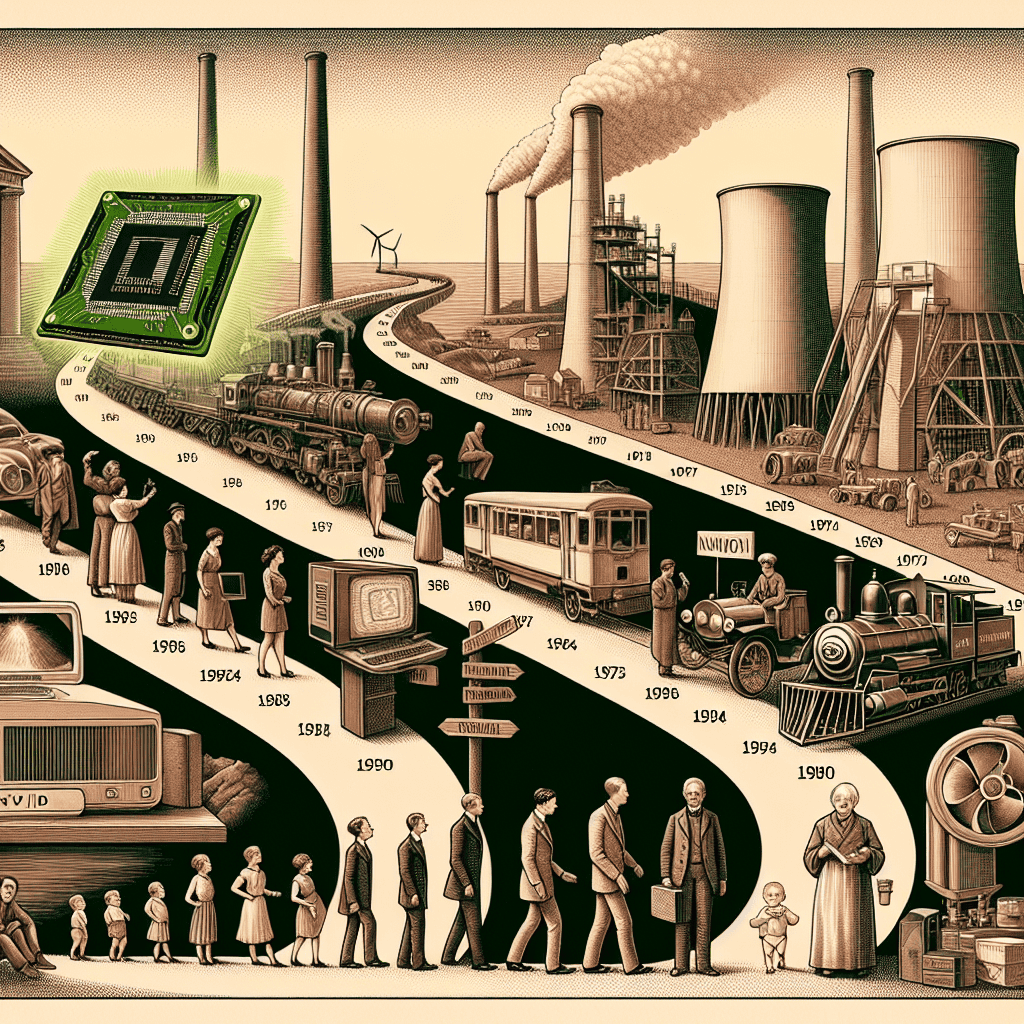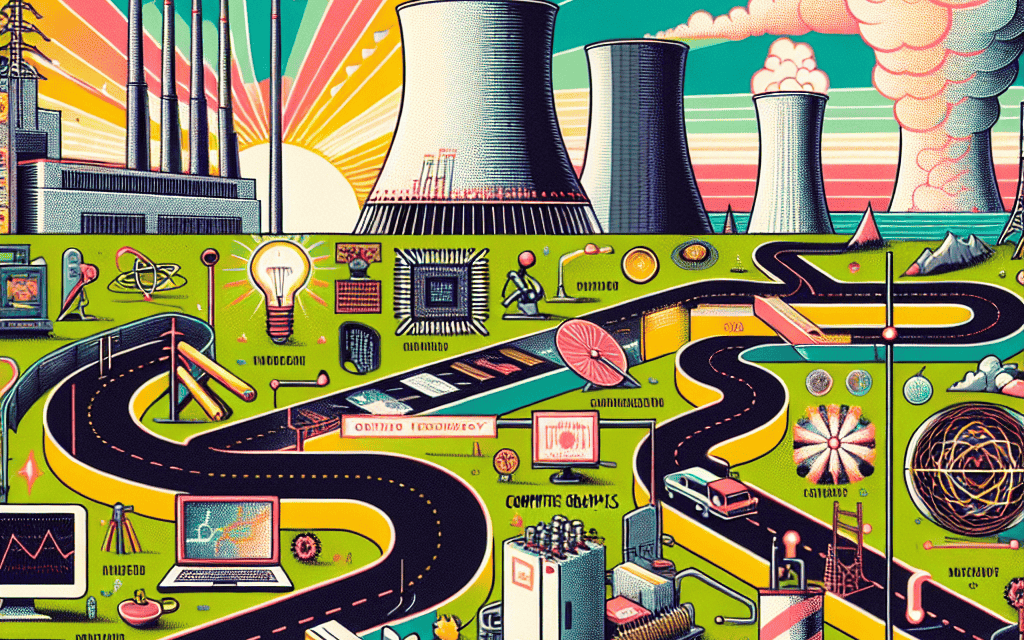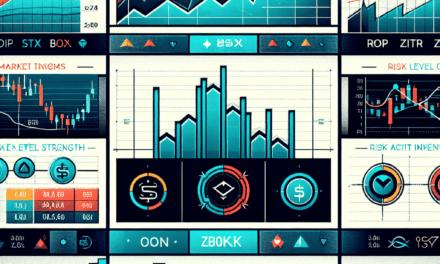“From Silicon to Fission: Exploring the Fusion of Innovation and Flavor”
Introduction
“From Nvidia to Nuclear Power: A Journey Through Technology and Taste” explores the dynamic intersection of cutting-edge technology and the evolving landscape of energy solutions. This narrative delves into Nvidia’s pioneering advancements in graphics processing and artificial intelligence, highlighting their transformative impact on various industries. Simultaneously, it examines the resurgence of nuclear power as a sustainable energy source, addressing both its potential and challenges. By weaving together these seemingly disparate threads, the book offers a comprehensive look at how technological innovation and energy strategies are shaping the future, influencing everything from digital experiences to global sustainability efforts.
Exploring Nvidia’s Impact on Modern Technology
Nvidia, a name synonymous with cutting-edge graphics technology, has profoundly influenced modern technology, extending its reach far beyond the realm of gaming. Initially recognized for its powerful graphics processing units (GPUs), Nvidia has become a pivotal player in various technological sectors, including artificial intelligence (AI), data centers, and autonomous vehicles. This transformation underscores the company’s adaptability and foresight in anticipating the needs of a rapidly evolving digital landscape.
To begin with, Nvidia’s GPUs have revolutionized the gaming industry by delivering unparalleled visual experiences. The company’s commitment to innovation has consistently pushed the boundaries of what is possible in digital graphics, enabling more realistic and immersive gaming environments. However, the impact of Nvidia’s technology extends well beyond entertainment. The same processing power that enhances gaming experiences is now being harnessed to drive advancements in AI and machine learning. Nvidia’s GPUs are particularly well-suited for these applications due to their ability to perform parallel processing, which is essential for handling the vast amounts of data required for AI algorithms.
Moreover, Nvidia’s influence is evident in the realm of data centers, where its technology is employed to optimize performance and efficiency. As businesses increasingly rely on cloud computing and big data analytics, the demand for robust and efficient data processing solutions has surged. Nvidia’s GPUs provide the computational power necessary to manage these complex tasks, enabling faster data processing and analysis. This capability is crucial for industries ranging from finance to healthcare, where timely and accurate data insights can drive significant improvements in decision-making and operational efficiency.
In addition to its contributions to AI and data centers, Nvidia is also at the forefront of the autonomous vehicle revolution. The company’s DRIVE platform is designed to support the development of self-driving cars by providing the computational power needed to process the vast amounts of data generated by vehicle sensors. This technology is instrumental in enabling real-time decision-making, which is critical for the safe and efficient operation of autonomous vehicles. As the automotive industry continues to evolve, Nvidia’s technology is poised to play a central role in shaping the future of transportation.
Furthermore, Nvidia’s impact on modern technology is not limited to its hardware innovations. The company has also made significant strides in software development, creating platforms and tools that facilitate the integration of its technology into various applications. For instance, Nvidia’s CUDA platform allows developers to harness the power of GPUs for general-purpose computing, opening up new possibilities for scientific research, engineering, and other fields that require intensive computational resources.
In conclusion, Nvidia’s journey from a graphics card manufacturer to a leader in modern technology is a testament to its ability to adapt and innovate. By expanding its focus beyond gaming, Nvidia has positioned itself as a key player in several high-growth industries, including AI, data centers, and autonomous vehicles. As technology continues to advance at a rapid pace, Nvidia’s contributions will undoubtedly remain integral to shaping the future of these sectors. Through its relentless pursuit of innovation, Nvidia exemplifies the transformative power of technology and its potential to drive progress across diverse fields.
The Evolution of Nuclear Power: Past, Present, and Future
The evolution of nuclear power is a fascinating journey that intertwines technological advancements with societal needs and environmental considerations. From its inception in the mid-20th century, nuclear power has been a subject of both admiration and controversy. Initially, the discovery of nuclear fission opened up a new realm of possibilities, promising an era of abundant and clean energy. The first commercial nuclear power plants emerged in the 1950s, marking a significant milestone in energy production. These early reactors were based on designs that prioritized efficiency and output, setting the stage for nuclear power to become a cornerstone of the global energy mix.
As the years progressed, the nuclear industry faced numerous challenges, both technical and societal. The accidents at Three Mile Island in 1979 and Chernobyl in 1986 highlighted the potential risks associated with nuclear power, leading to increased scrutiny and regulatory oversight. These incidents underscored the importance of safety and prompted significant advancements in reactor design and operational protocols. Consequently, the industry adopted more robust safety measures, including redundant safety systems and improved emergency response strategies, to mitigate the risks of nuclear accidents.
In the present day, nuclear power continues to play a crucial role in the global energy landscape. It provides a substantial portion of the world’s electricity, contributing to energy security and helping to reduce greenhouse gas emissions. The development of advanced reactor technologies, such as small modular reactors (SMRs) and Generation IV reactors, represents a significant leap forward in the quest for safer and more efficient nuclear power. These innovations promise to address some of the longstanding concerns associated with traditional nuclear reactors, such as waste management and the potential for catastrophic failures.
Looking to the future, the role of nuclear power is poised to evolve further as the world grapples with the urgent need to transition to sustainable energy sources. The growing emphasis on decarbonization and the fight against climate change have renewed interest in nuclear energy as a viable solution. In this context, nuclear power offers a reliable and low-carbon alternative to fossil fuels, complementing renewable energy sources like wind and solar. Moreover, the potential for nuclear fusion, often regarded as the “holy grail” of energy, holds promise for a future where clean and virtually limitless energy becomes a reality.
However, the path forward is not without its challenges. Public perception of nuclear power remains mixed, with concerns about safety, waste disposal, and the high costs of plant construction and decommissioning. To address these issues, ongoing research and development efforts are focused on enhancing the safety and economic viability of nuclear technologies. Additionally, fostering public trust through transparent communication and community engagement is essential to gaining broader acceptance of nuclear power as a key component of the energy transition.
In conclusion, the evolution of nuclear power is a testament to human ingenuity and the relentless pursuit of progress. From its early days of promise and peril to its current role in addressing global energy challenges, nuclear power has continually adapted to meet the needs of society. As we look to the future, the continued advancement of nuclear technology, coupled with a commitment to safety and sustainability, will be crucial in shaping a world where energy is both abundant and environmentally responsible.
How Nvidia’s Innovations Are Shaping the Future of AI
Nvidia, a name synonymous with cutting-edge graphics processing units (GPUs), has become a pivotal player in the realm of artificial intelligence (AI). As the world increasingly leans on AI to solve complex problems, Nvidia’s innovations are at the forefront, driving advancements that are shaping the future of this transformative technology. The company’s GPUs, originally designed to render high-quality graphics for gaming, have found a new purpose in AI, where their parallel processing capabilities are ideally suited for the massive computational demands of machine learning algorithms.
The journey of Nvidia from a graphics card manufacturer to a leader in AI technology is a testament to the company’s ability to adapt and innovate. At the heart of this transformation is the development of the CUDA parallel computing platform and programming model. CUDA enables developers to harness the power of Nvidia GPUs for general-purpose processing, making it possible to accelerate computational tasks that were once the exclusive domain of traditional CPUs. This shift has opened up new possibilities in AI research and development, allowing for the rapid training of complex neural networks that underpin modern AI applications.
Moreover, Nvidia’s contribution to AI extends beyond hardware. The company has invested heavily in software ecosystems that support AI development. For instance, the Nvidia Deep Learning SDK provides developers with a suite of tools and libraries that simplify the process of building, training, and deploying AI models. This comprehensive approach ensures that Nvidia remains a key enabler of AI innovation, providing both the hardware and software necessary to push the boundaries of what is possible.
In addition to its technical contributions, Nvidia has also played a significant role in fostering a collaborative AI community. By hosting events such as the GPU Technology Conference (GTC), Nvidia brings together researchers, developers, and industry leaders to share insights and explore new frontiers in AI. These gatherings serve as a catalyst for innovation, sparking new ideas and collaborations that drive the field forward.
As AI continues to evolve, Nvidia’s influence is evident in a wide range of applications. In healthcare, for example, Nvidia’s technology is being used to develop AI models that can analyze medical images with unprecedented accuracy, aiding in the early detection of diseases. In the automotive industry, Nvidia’s GPUs power the AI systems that enable autonomous vehicles to navigate complex environments safely. Furthermore, in the realm of scientific research, Nvidia’s technology is accelerating simulations and data analysis, leading to breakthroughs in fields such as climate modeling and genomics.
Looking to the future, Nvidia’s commitment to AI innovation shows no signs of waning. The company’s recent developments in AI hardware, such as the introduction of the A100 Tensor Core GPU, promise to deliver even greater performance and efficiency. These advancements will undoubtedly fuel the next wave of AI applications, enabling more sophisticated models and expanding the potential of AI to address global challenges.
In conclusion, Nvidia’s journey from a graphics card manufacturer to a leader in AI technology is a remarkable story of innovation and adaptation. Through its cutting-edge hardware, robust software ecosystems, and commitment to fostering a collaborative AI community, Nvidia is shaping the future of AI in profound ways. As we continue to explore the possibilities of AI, Nvidia’s contributions will remain a cornerstone of this exciting technological frontier.
The Intersection of Technology and Culinary Arts

In recent years, the intersection of technology and culinary arts has emerged as a fascinating domain, where innovation meets tradition to create new experiences for both chefs and diners. This convergence is not merely a superficial blend of two distinct fields but rather a profound integration that is reshaping the culinary landscape. At the forefront of this transformation are advancements in technology, from the computational prowess of companies like Nvidia to the energy innovations in nuclear power, each contributing uniquely to the culinary world.
Nvidia, a leader in graphics processing technology, has extended its influence beyond gaming and artificial intelligence into the culinary arts. The company’s powerful GPUs are now being utilized to enhance food photography and virtual reality dining experiences. By enabling hyper-realistic visualizations, Nvidia’s technology allows chefs to design and present dishes in a virtual space before they are physically created. This not only aids in perfecting presentation but also in experimenting with flavors and textures in a simulated environment, reducing waste and fostering creativity.
Moreover, the rise of artificial intelligence, powered by companies like Nvidia, has led to the development of smart kitchen appliances. These devices, equipped with machine learning algorithms, can predict cooking times, suggest recipes based on available ingredients, and even adjust cooking temperatures to ensure perfect results. Such innovations are transforming home cooking and professional kitchens alike, making culinary arts more accessible and efficient.
Transitioning from the digital realm to the physical, the role of energy in culinary arts cannot be overlooked. Nuclear power, often associated with large-scale energy production, is finding its way into the culinary sector through the concept of precision cooking. This method involves using controlled energy sources to cook food at exact temperatures, ensuring consistency and enhancing flavors. While nuclear power itself is not directly used in kitchens, the principles of precision and control it embodies are being adopted in modern cooking techniques.
Furthermore, the sustainability aspect of nuclear energy resonates with the growing demand for eco-friendly culinary practices. As chefs and restaurateurs seek to reduce their carbon footprint, the efficient energy use exemplified by nuclear power serves as an inspiration for developing sustainable cooking methods. This includes the adoption of energy-efficient appliances and the exploration of alternative energy sources to power kitchens, aligning with the broader movement towards environmental responsibility in the culinary arts.
In addition to technological advancements, the cultural implications of this intersection are profound. The integration of technology into culinary arts is democratizing the field, allowing a wider audience to engage with and appreciate the intricacies of cooking. Virtual reality dining experiences, for instance, enable individuals to explore global cuisines from the comfort of their homes, breaking down geographical barriers and fostering a deeper understanding of diverse culinary traditions.
In conclusion, the intersection of technology and culinary arts is a dynamic and evolving field that is redefining how we perceive and engage with food. From the computational capabilities of Nvidia to the energy efficiency inspired by nuclear power, technology is enhancing the culinary experience in unprecedented ways. As these innovations continue to develop, they promise to further blur the lines between technology and taste, creating a future where culinary arts are not only about flavor but also about innovation and sustainability.
Nuclear Power: Debunking Myths and Misconceptions
In the realm of technological advancements, few topics are as polarizing and misunderstood as nuclear power. While companies like Nvidia push the boundaries of computing technology, revolutionizing industries with their cutting-edge graphics processing units, nuclear power remains shrouded in myths and misconceptions. This disparity in perception often stems from a lack of understanding about the fundamental principles and safety measures that govern nuclear energy. As we delve into the world of nuclear power, it is crucial to debunk these myths and provide a clearer picture of its potential and safety.
To begin with, one of the most pervasive myths surrounding nuclear power is the belief that it is inherently unsafe. This misconception is often fueled by high-profile incidents such as the Chernobyl disaster in 1986 and the Fukushima Daiichi accident in 2011. However, it is important to recognize that these events were the result of specific circumstances and outdated technology. Modern nuclear reactors are designed with multiple layers of safety systems, including redundant cooling systems and robust containment structures, to prevent such catastrophes. Furthermore, the nuclear industry is subject to stringent regulatory oversight, ensuring that safety protocols are continuously updated and rigorously enforced.
Another common misconception is that nuclear power contributes significantly to environmental pollution. In reality, nuclear energy is one of the cleanest sources of power available today. Unlike fossil fuels, nuclear reactors do not emit carbon dioxide during operation, making them a vital component in the fight against climate change. The primary byproduct of nuclear energy is spent fuel, which, although radioactive, is managed through secure storage and disposal methods. Advances in technology are also paving the way for recycling spent fuel, further minimizing its environmental impact.
Moreover, there is a widespread belief that nuclear power is prohibitively expensive. While it is true that the initial costs of building a nuclear power plant are high, the long-term benefits often outweigh these expenses. Nuclear plants have a long operational lifespan, typically exceeding 40 years, and they provide a stable and reliable source of energy. Additionally, the cost of uranium, the primary fuel for nuclear reactors, is relatively low and stable compared to the volatile prices of fossil fuels. As a result, nuclear power can offer a cost-effective solution for meeting the growing global energy demand.
Transitioning from these misconceptions, it is essential to highlight the role of nuclear power in the broader context of energy diversification. As the world seeks to reduce its reliance on fossil fuels, nuclear energy presents a viable alternative that can complement renewable sources like wind and solar. Unlike renewables, which are subject to weather conditions and geographic limitations, nuclear power provides a consistent and reliable energy supply. This reliability is crucial for maintaining grid stability and ensuring that energy demands are met without interruption.
In conclusion, while the journey from Nvidia’s technological innovations to the realm of nuclear power may seem disparate, both represent the forefront of human ingenuity and potential. By debunking myths and misconceptions about nuclear energy, we can better appreciate its role in a sustainable energy future. As we continue to explore and embrace diverse technological solutions, it is imperative to approach nuclear power with an informed perspective, recognizing its safety, environmental benefits, and economic viability. Through this understanding, we can harness the full potential of nuclear energy as a cornerstone of a cleaner and more sustainable world.
The Role of Nvidia in Advancing Gaming Technology
Nvidia, a name synonymous with cutting-edge graphics technology, has played a pivotal role in advancing gaming technology over the past few decades. As the gaming industry has evolved, so too has the demand for more sophisticated and immersive experiences. Nvidia has consistently risen to this challenge, pushing the boundaries of what is possible in gaming graphics and performance. The company’s journey in the gaming sector began with the introduction of its first graphics processing unit (GPU), the GeForce 256, in 1999. This innovation marked a significant leap forward, as it was the first GPU to integrate a transform and lighting engine, which allowed for more realistic 3D graphics. This development set the stage for Nvidia’s continued influence in the gaming world.
As gaming technology advanced, Nvidia’s GPUs became increasingly powerful, enabling developers to create more complex and visually stunning games. The introduction of the GeForce GTX series further solidified Nvidia’s position as a leader in the industry. These GPUs offered unprecedented levels of performance, allowing for higher resolutions, faster frame rates, and more detailed textures. This, in turn, enhanced the overall gaming experience, making it more immersive and engaging for players. Moreover, Nvidia’s commitment to innovation did not stop at hardware. The company also developed software solutions, such as the Nvidia GameWorks suite, which provided developers with tools to create more realistic physics, lighting, and visual effects. This suite of tools has been instrumental in pushing the boundaries of what is possible in gaming, enabling developers to create worlds that are not only visually stunning but also more interactive and dynamic.
In addition to its contributions to graphics and performance, Nvidia has also been at the forefront of advancing virtual reality (VR) technology. The company’s GPUs are designed to handle the demanding requirements of VR, providing the necessary power to deliver smooth and immersive experiences. Nvidia’s VRWorks software further enhances this experience by optimizing performance and reducing latency, ensuring that players can fully immerse themselves in virtual worlds without any disruptions. As a result, Nvidia has played a crucial role in making VR more accessible and appealing to a broader audience.
Furthermore, Nvidia’s influence extends beyond traditional gaming platforms. The company’s technology is also used in cloud gaming services, which allow players to stream games over the internet without the need for high-end hardware. This has opened up new possibilities for gaming, making it more accessible to people who may not have the resources to invest in expensive gaming rigs. By leveraging its expertise in GPUs and cloud computing, Nvidia has helped to democratize gaming, allowing more people to enjoy high-quality gaming experiences regardless of their hardware limitations.
In conclusion, Nvidia’s contributions to the gaming industry have been nothing short of transformative. Through its relentless pursuit of innovation, the company has consistently pushed the boundaries of what is possible in gaming technology. From its early days with the GeForce 256 to its current advancements in VR and cloud gaming, Nvidia has played a crucial role in shaping the gaming landscape. As technology continues to evolve, it is clear that Nvidia will remain at the forefront, driving the industry forward and ensuring that gaming experiences continue to become more immersive, realistic, and accessible to players around the world.
Sustainable Energy Solutions: The Promise of Nuclear Power
In the ever-evolving landscape of technology and energy, the journey from Nvidia’s cutting-edge advancements in computing to the promising realm of nuclear power highlights a fascinating intersection of innovation and sustainability. As we delve into the potential of nuclear power as a sustainable energy solution, it is essential to consider the broader context of technological progress and its implications for the future of energy.
Nvidia, a leader in the field of graphics processing units (GPUs) and artificial intelligence, has revolutionized the way we approach complex computational tasks. Their innovations have not only transformed industries such as gaming and data science but have also paved the way for advancements in energy efficiency and resource management. By harnessing the power of AI, Nvidia has enabled more precise modeling and simulation capabilities, which are crucial in optimizing energy systems and reducing waste. This technological prowess serves as a testament to the potential of human ingenuity in addressing global challenges.
Transitioning from the digital realm to the physical world, the promise of nuclear power emerges as a compelling solution to the pressing issue of sustainable energy. Unlike fossil fuels, nuclear power offers a low-carbon alternative that can significantly reduce greenhouse gas emissions. As the world grapples with the impacts of climate change, the need for reliable and clean energy sources has never been more urgent. Nuclear power, with its ability to generate large amounts of electricity with minimal environmental impact, presents a viable path forward.
However, the journey towards embracing nuclear power is not without its challenges. Public perception, often shaped by historical incidents and misconceptions, remains a significant hurdle. The fear of nuclear accidents and concerns about radioactive waste disposal continue to influence public opinion and policy decisions. Nevertheless, advancements in nuclear technology, such as the development of small modular reactors (SMRs) and improved safety protocols, are gradually addressing these concerns. These innovations promise to enhance the safety, efficiency, and scalability of nuclear power, making it a more attractive option for sustainable energy production.
Moreover, the integration of nuclear power into the broader energy landscape requires careful consideration of economic and logistical factors. The initial costs of building nuclear power plants are substantial, and the regulatory environment can be complex. Yet, the long-term benefits, including energy security and price stability, offer compelling incentives for investment. As countries strive to diversify their energy portfolios and reduce reliance on fossil fuels, nuclear power stands out as a strategic component of a balanced and resilient energy mix.
In conclusion, the journey from Nvidia’s technological advancements to the promise of nuclear power underscores the interconnectedness of innovation and sustainability. As we navigate the complexities of the modern energy landscape, it is crucial to leverage the strengths of both digital and physical technologies. By embracing the potential of nuclear power, alongside other renewable energy sources, we can forge a path towards a more sustainable and secure energy future. This journey requires collaboration, investment, and a willingness to challenge preconceived notions, but the rewards—a cleaner environment and a more stable climate—are well worth the effort. As we continue to explore the possibilities, the synergy between technology and sustainable energy solutions will undoubtedly play a pivotal role in shaping the world of tomorrow.
Q&A
1. **What is the main theme of “From Nvidia to Nuclear Power: A Journey Through Technology and Taste”?**
– The main theme is the exploration of technological advancements and their impact on various industries, including computing and energy, while also touching on cultural and sensory experiences.
2. **How does Nvidia contribute to technological advancements?**
– Nvidia contributes through its development of powerful GPUs that enhance computing capabilities, enabling advancements in AI, machine learning, and graphics processing.
3. **What role does nuclear power play in the narrative?**
– Nuclear power is discussed as a significant and controversial energy source, highlighting its potential for providing large-scale, low-carbon energy amidst concerns about safety and waste management.
4. **How are technology and taste connected in the journey?**
– The connection is made by examining how technological innovations influence cultural experiences and consumer preferences, such as in the food industry with precision agriculture and food tech.
5. **What industries are highlighted in the journey besides computing and energy?**
– Besides computing and energy, the journey highlights industries like agriculture, food technology, and entertainment, showcasing the broad impact of technological advancements.
6. **What challenges are associated with nuclear power according to the text?**
– Challenges include safety concerns, radioactive waste disposal, high costs, and public perception issues, which complicate its adoption despite its potential benefits.
7. **What future trends in technology are anticipated in the narrative?**
– Future trends include the continued integration of AI and machine learning across sectors, advancements in renewable energy technologies, and the evolution of consumer experiences through tech-driven innovations.
Conclusion
“From Nvidia to Nuclear Power: A Journey Through Technology and Taste” explores the intersection of cutting-edge technology and its broader implications on society and culture. The narrative delves into how advancements in computing, exemplified by Nvidia’s innovations, are reshaping industries and everyday life, while also examining the transformative potential of nuclear power in addressing global energy challenges. By weaving together these themes, the piece highlights the dynamic interplay between technological progress and human experience, ultimately suggesting that the future will be defined by how we harness these powerful tools to enhance both efficiency and quality of life.





